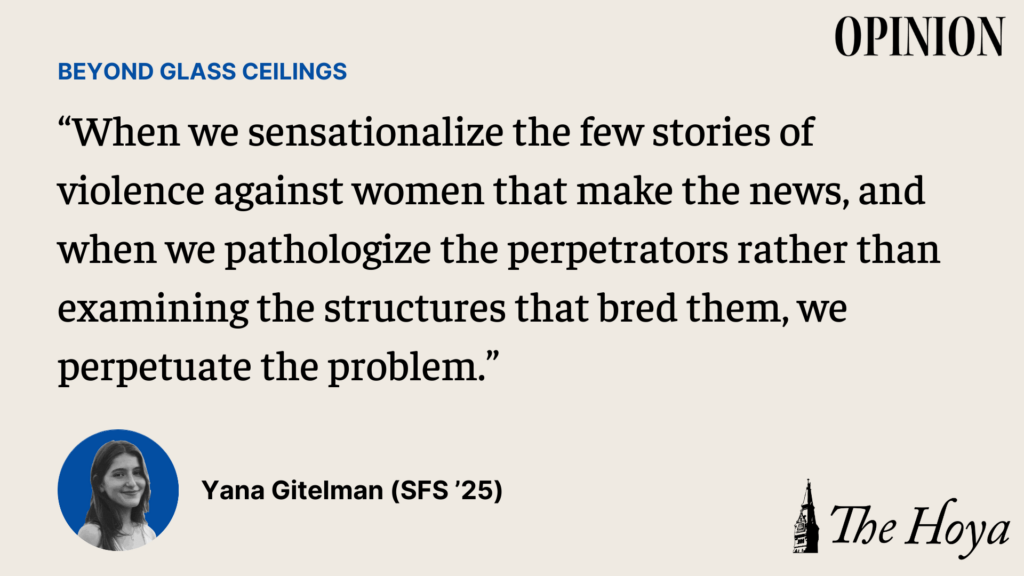CONTENT WARNING: This article discusses domestic abuse, sexual assault and gender-based violence. Please refer to the end of the article for on- and off-campus resources.
Every major U.S. news outlet has been running stories about Gabby Petito’s disappearance since September. While Brian Laundrie’s body has been found, officials have not officially confirmed that he killed her. He is still a person of interest. But I and every woman I know feel certain that he did.
When we hear stories of women like Gabby, we have a tendency to individualize them to a fault. However, they are not as uncommon or distant as we want to believe. Stories only tend to surface about victims that fit an image of “purity”: white, blonde, thin, in a relationship and innocent. But meanwhile, marginalized women experience violence at enormous rates. Indigenous women are murdered at a rate 10 times that of the national average. Sex workers are at least 60 times more likely to be murdered than the average woman. When we sensationalize the few stories of violence against women that make the news, and when we pathologize the perpetrators rather than examining the structures that bred them, we perpetuate the problem. I use “we” broadly here; I would love to blame the media or blatant misogynists, but even well-intentioned self-proclaimed feminists feed into this dynamic.
Witnesses saw a physical “altercation” between the couple Aug. 12, in which Laundrie reportedly slapped and hit Petito. The Moab, Utah, police chose to believe Laundrie’s insistence that they were safe and in love. A police report described Petito as “confused and emotional” and chalked the fight down as a “mental health crisis” on her part. One officer suggested the couple separate for the night to “reset their mental states” but took no steps to enforce this separation or protect Gabby. This is a story of police neglecting a vulnerable woman and of a dangerous man emboldened by receiving the benefit of the doubt. This is a story of the failure of those few police officers to read the situation accurately and respond with appropriate concern. It extends far beyond police incompetence, however: These officers’ perception of the conflict was shaped by a society that more readily casts blame on women’s hysteria than men’s violence.
This is where the “no one could have suspected him” narrative comes into play. The truth is, someone could have suspected him. The narrative that we couldn’t, that the perpetrators of intimate violent acts house some invisible, secret capacity for harm inside of them, is both inaccurate and deeply harmful. This narrative takes the responsibility and blame off of everyone who likely enabled him throughout his life, who failed to hold him accountable for his small acts of violence, anger and entitlement. Every woman I know can report at least a handful of loved ones and acquaintances who have been harassed or assaulted, but few perpetrators are held accountable in any sense.
We all have a responsibility to upend the systems and expectations that continue to enable these offenders. Every girl I know is acutely aware of the dangers she is predisposed to as a result of her gender. Grim statistics housed in the back of my mind spring to the forefront nearly every time I find myself in a group of exactly five women. Personally, I experienced street harassment for the first time at age 12 when I started going to school on my own. Soon after, I began to experience the phenomenon of men not understanding why being berated and followed was not a compliment. Catcalling can feel like a threat because women grow up hyperaware of the bodily danger we face while simply moving through the world. Incidents of sexual harassment and assault alike are a reminder of the fact that we do not get to walk to work confident that we will not be physically harmed or worse.
Violence against women is pervasive, almost to the point of omnipresence. Where violence is absent, reinforcing language from rape jokes to victim blaming can usually still be found. Even in the few places I’ve seen the rates of violence against the most marginalized groups of women publicized and given a fraction of the attention they deserve, individual victims are rarely mentioned. The stories we hear — the missing women who even get the dignity of a local news article — are only the tip of the iceberg of this major humanitarian crisis.
Our reaction to stories like Gabby’s cannot end at “this is so sad.” We owe it to all women — those who have been killed, those who have survived violence and those who are trying hard to beat the odds as we grow up in a world that does not truly value our safety — to dedicate ourselves to preventing this violence.
Yana Gitelman is a first-year in the School of Foreign Service. Beyond Glass Ceilings is published every other week.
On-campus resources include Health Education Services (202-687-8949) and Counseling and Psychiatric Service (202-687-6985); additional off-campus resources include the D.C. Rape Crisis Center (202-333-7273) and the D.C. Forensic Nurse Examiner Washington Hospital Center (844-443-5732). If you or anyone you know would like to receive a sexual assault forensic examination or other medical care — including emergency contraception — call the Network for Victim Recovery of D.C. (202-742-1727). To report sexual misconduct, you can contact Georgetown’s Title IX coordinator (202-687-9183) or file an online report here. Emergency contraception is available at the CVS located at 1403 Wisconsin Ave NW and through H*yas for Choice. For more information, visit sexualassault.georgetown.edu.














